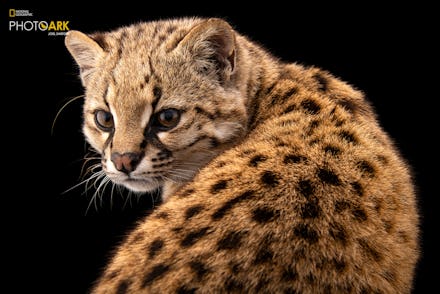Meet the guy trying to photograph every zoo animal in the world

There are approximately 15,000 animal species living in sanctuaries and zoos, many of them endangered or at risk of extinction in the wild. Wildlife photographer Joel Sartore has made it his mission to record all of them before it's too late. Through the National Geographic Photo Ark, an ambitious project that has sent Sartore to over 50 countries and hundreds of zoos, aquariums, and animal rescue centers all over the globe, he's a modern-day Noah building a digital ark to preserve the existence of these creatures.
The project began nearly 15 years ago, and on Friday Sartore added a güiña — an incredibly adorable, small, wildcat — marking the 10,000th species aboard the ark. To capture this rare feline, Sartore had to travel to a wildlife reserve in Chile called Fauna Andina, where it's protected from the usual threats like human development and activity, death by poultry farmers, and diseases passed along by domestic cats.
In one video, the güiña curiously looks around as it makes an almost bird-like sound. According to National Geographic, scientists and conservationists believe this video is the first time an audio recording of the güiña has been published.
Despite the animals being in captivity, taking and cataloging all of their photos is no small task.
"I work directly with zoos and wildlife sanctuaries to prep for the photo shoot beforehand," Sartore explains to Mic. "Sometimes this process can take months."
This is to keep all animals safe and comfortable as he records them. He consults with the caretakers and specialists at each facility, who help him with each photo session.
"These experts advise me on which animals would be most comfortable being handled and photographed and instruct me on when the photo shoots should end," he says. "They typically only last a few minutes."
Surprisingly, the black and white backgrounds in each portrait aren't inserted by using photo editing software, either.
"All animals photographed for the Photo Ark are put on black and white backgrounds, using paint, plastic, cloth or paper, to keep the photo shoots are short as possible," Sartore reveals. "Often for larger animals, the animals have been habituated to the black and white backgrounds over a period of time in their enclosures well before the shoot day."
Sartore plans his sessions with equality in mind — every creature, whether mammal or insect, receives the same respect in his photographs.
"I use studio lighting and black and white backgrounds to level the playing field for all species featured in the National Geographic Photo Ark," he says. "Since no size comparison is possible, a mouse is every bit as large (and important) as an elephant."
Without backgrounds, the animal becomes the absolute focus of all his images. "The solid backgrounds also eliminate distractions, allowing viewers to look deeply into the eyes of these animals and see their true beauty and worthiness, and connect most directly with them."
This eye-to-eye connection is vital to Sartore and the Photo Ark. According to National Geographic, more than 26,000 species around the world are near extinction. That's a lot of species that some people haven't even heard of, let alone seen, which is what Sartore is trying to change.
"Through the Photo Ark we've been able to raise the profile of species that otherwise wouldn't get the attention they deserve," Sartore said in a press release. But images like these, he believes, "engage [people's] feelings of compassion and a desire to help."
The Photo Ark also plays a part as a valuable resource for educators and conservation outreach projects.
With the addition of the güiña, Sartore is two-thirds of the way finished with the Photo Ark.
"I am excited about reaching this milestone," he tells Mic, "but we still have a lot of work ahead of us. [...] We'll now have to travel farther and wider to get the remaining species."
All the effort is worth it, he says, if these images can light a fire in people to learn how they can help save the world's biodiversity.
"I want my photos and video to inspire action," says Sartore. "I hope this connection will inspire people to take action and protect these animals before it’s too late."
Correction: An earlier headline on this article stated the number of animals to be photographed for the Ark as 30,000. It is an estimated 15,000.